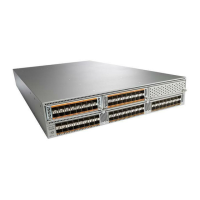Cisco Nexus devices provide quality of service (QoS) capabilities to ensure lossless or best-effort service
across the switch. For Fibre Channel traffic (FCoE) you should apply the lossless QoS classes. By default,
best-effort service is applied to all of the Ethernet traffic. You can configure different QoS levels for specific
classes of Ethernet traffic.
Virtual Interfaces
When FCoE is enabled, a physical Ethernet cable carries traffic for a logical Fibre Channel connection.
The Cisco Nexus device uses virtual interfaces to represent the logical Fibre Channel connections. For
configuration purposes, virtual Fibre Channel interfaces are implemented as Layer 2 subinterfaces of the
physical Ethernet interface.
Ethernet features (such as the link debounce timer and VLAN membership) are configured on the physical
Ethernet interface. Logical Fibre Channel features (such as VSAN membership) are configured on the virtual
Fibre Channel interfaces.
Ethernet Switching
Cisco Nexus devices are Layer 2 devices, which run Cisco NX-OS.
Cisco Nexus devices are designed to support high-density, high-performance Ethernet systems and provide
the following Ethernet switching features:
•
IEEE 802.1D-2004 Rapid and Multiple Spanning Tree Protocols (802.1w and 802.1s)
•
IEEE 802.1Q VLANs and trunks
•
IEEE 802.3ad link aggregation
•
Private VLANs
•
EtherChannels and virtual port channels (vPCs)
•
Traffic suppression (unicast, multicast, and broadcast)
FCoE and Fibre Channel Switching
Cisco Nexus devices support data center I/O consolidation by providing FCoE interfaces (to the servers) and
native Fibre Channel interfaces (to the SAN).
FCoE and Fibre Channel switching includes the following features:
•
Cisco fabric services
•
N-port virtualization
•
VSANs and VSAN trunking
•
Zoning
•
Distributed device alias service
•
SAN port channels
Cisco Nexus 5500 Series NX-OS Fundamentals Configuration Guide, Release 7.x
OL-30890-01 5
Overview
Virtual Interfaces

